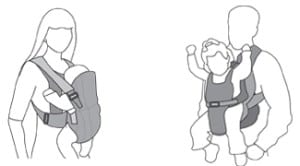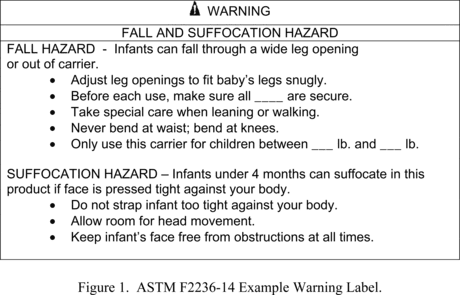CPSC Issues Final Rule Safety Standard Soft Infant Toddler Carriers
The CPSC has issued a Final Rule on the Safety Standard for Soft Infant and Toddler Carriers, 16 CFR 1226 on March 28, 2014. This final rule will become effective on September 29, 2014 and apply to products manufactured or imported on or after that date. The ASTM standard for Soft Infant and Toddler Carriers, ASTM F2236-14, which was released on January 1, 2014, incorporates all the new mandatory requirements of the Final Rule.
ASTM F2236-14’s definition of a “soft infant and toddler carrier” distinguishes soft infant and toddler carriers from other types of infant carriers that are also worn by a caregiver but that are not covered under ASTM F-2236-14, specifically slings (including wraps), and framed backpack carriers.
Soft infant and toddler carriers are designed to carry a child in an upright position. Slings are designed to carry a child in a reclined position. However, some slings may also be used to carry a child upright. The primary distinction between a sling and a soft infant and toddler carrier is that a sling allows for carrying a child in a reclined position. Different hazard patterns arise from carrying a child in a reclined position. Accordingly, slings are not covered by the standard for soft infant and toddler carriers.
Like soft infant and toddler carriers, framed backpack carriers are intended to carry a child in an upright position. However, framed backpack carriers are distinguishable from soft infant and toddler carriers because typically, backpack carriers are constructed of sewn fabric over a rigid frame and are intended solely for carrying a child on the caregiver’s back.
ASTM F2236-14 includes the following key provisions: scope, terminology, general requirements, performance requirements, test methods, marking and labeling, and instructional literature.
Scope
The scope of the voluntary standard was broadened in December 2012 to include soft infant and toddler carriers with an upper weight limit of up to 45 pounds. Previously, it was unclear whether carriers with upper weight limits over 25 pounds fell within the standard. Expanding the scope of the standard clarifies that all soft infant and toddler carrier products currently on the market fall within the standard.
Terminology
Section 3.1 of the standard includes 14 definitions to help explain general requirements and performance requirements. Section 3.1.7 of the standard explains that a “leg opening” is the “opening in the soft carrier through which the occupant’s legs extend when the product is used in the manufacturer’s recommended use position.” Sections 3.1.4 and 3.1.13 of ASTM F2236-14, respectively, explain that a “dynamic load” is the “application of impulsive force through free fall of a weight,” and that a “static load” is a “vertically downward force applied by a calibrated force gage or by dead weights.” Beginning in 2012, the standard included a new definition for “carrying position” to clarify methods for dynamic and static load testing in section 7 of the standard. Finally, in 2013, the standard was updated to include a new definition for “fastener” to aid in a new test for fastener strength and strap retention.
General Requirements
ASTM F2236-14 includes general requirements that the products must meet, as well as specified test methods to ensure compliance with the general requirements, which include:
- restrictions on sharp points or edges, as defined by 16 CFR §§ 1500.48 and .49;
- restrictions on small parts, as defined by 16 CFR part 1501;
- restrictions on lead in paint, as set forth in 16 CFR part 1303;
- requirements for locking and latching devices;
- requirements for permanent warning labels;
- restrictions on flammability, as set forth in 16 CFR part 1610;
- requirements for toy accessories, as set forth in ASTM F 963.
The flammability requirement in section 5.7 of the standard was changed, beginning with ASTM F2236-13, from a flammable solids requirement (16 CFR 1500.3(c)(6)(vi)), to meet the more stringent flammability requirement for wearing apparel (16 CFR part 1610). Adopting the wearing apparel flammability requirement in the soft infant and toddler standard makes it consistent with other wearable infant carriers made of sewn fabric, such as slings, to prevent a foreseeable fire hazard in all wearable infant carriers.
Performance Requirements and Test Methods
ASTM F2236-14 provides performance requirements and test methods that are designed to protect against falls from the carrier due to large leg openings, breaking fasteners or seams, and straps that slip, including:
Leg Openings
Tested leg openings must not permit passage of a test sphere weighing 5 pounds that is 14.75 inches in circumference.
Dynamic and Static Load
Beginning with the 2012 version of ASTM F2236, the dynamic load test was strengthened from requiring a 25-pound shot bag to be dropped, free fall, from 1 inch above the seat area onto the carrier seat 1,000 times, to requiring testing with a 25-pound shot bag, or a shot bag equal to the manufacturer’s maximum occupant weight limit, whichever is heavier. Additionally, the static load test was revised—from requiring a 75-pound weight for testing—to requiring a 75-pound weight, or a weight equal to three times the manufacturer’s recommended maximum occupant weight, whichever is greater, to be placed in the seat area of the carrier for 1 minute. Such revisions to the dynamic and static load tests strengthen the test requirements, by requiring that products with a maximum recommended weight of 45 pounds be tested to a 135-pound weight instead of 75 pounds, which represents an 80 percent increase in the severity of the requirement.
ASTM F2236-14 requires that testing conducted with the new required loads must not result in a “hazardous condition,” as defined in the general requirements, or result in a structural failure, such as fasteners breaking or disengaging, or seams separating when tested in accordance with the dynamic and static load testing methods. Additionally, the standard provides that dynamic and static load testing must not result in adjustable sections of support/shoulder straps slipping more than 1 inch per strap from their original adjusted position after testing.
Section 6.2.2 of the standard on Support/Shoulder Strap Slippage was modified beginning with ASTM F2236-13a. The modification clarifies what constitutes passing or failing the strap slippage test. Section 6.2.2 was amended to state: “Adjustable sections of support/shoulder straps shall not slip, in a manner that loosens the strap, more than 1 in. (25 mm) per strap from their original adjusted position after dynamic and static load testing is performed in accordance with 7.2.1 and 7.2.2, respectively.” The amendment allows straps to tighten during testing but not loosen more than 1 inch, which is the intent of the testing.
Fastener Strength and Strap Retention
ASTM F2236-14 includes a new component-level performance requirement that was added to the standard in 2013 to evaluate the strength of fasteners and strap retention to help prevent falls from a carrier. Previously, soft infant and toddler carriers were recalled due to an occupant fall hazard caused by broken fasteners that passed the static and dynamic performance requirements in the then existing standard, ASTM F2236-10. Accordingly, the performance requirement in section 6.4 of ASTM F2236-14 states that load-bearing fasteners at the shoulder and waist of soft infant and toddler carriers, such as buckles, loops, and snaps, may not break or disengage; nor may their straps slip more than 1 inch when subjected to an 80-pound pull force. Adjustable leg opening fasteners must also be tested but are subjected to lower loads, a 45-pound pull force, because these fasteners do not carry the same load as fasteners at the shoulders and waist. ASTM F2236-14 requires that when tested, fasteners must not break or disengage, and adjustable elements must not slip more than 1 inch.
Similar to the strap slip requirement in the static and dynamic load testing section of the standard, ASTM also clarified the strap slip section of the fastener strength test section in ASTM F2236-13a. Sections 6.4.1 and 6.4.2 were amended to state: “Each unique fastener, except for leg opening adjustment fasteners as tested per 6.4.2, shall not break or disengage, and adjustable elements in straps shall not slip , in a manner that loosens the strap, more than 1 in. (2.5 cm) . . . .” This amendment allows straps to tighten during testing but not to loosen more than 1 inch, which is the intent of the testing.
Additionally, Note 1 to section 6.4 of the standard provides that the fastener strength and strap retention testing apply only to load-bearing fasteners. ASTM F2236-13 stated: “Fasteners intended to retain items such as, but not limited to, hoods, bibs and toy rings, are exempt from these requirements.” ASTM approved two changes to the language in Note 1 to clarify that several non-load-bearing features, “sleeping hoods” and “head adjustment fasteners,” are included in the list of examples exempted from fastener strength testing when such features are non-load-bearing. Note 1 in section 6.4 of ASTM F2236-14 now provides that: “Fasteners intended to retain items such as, but not limited to, sleeping hoods, head adjustment fasteners, bibs and toy rings, are exempt from these requirements.”
Unbounded Leg Opening
The voluntary standard was updated in 2013 to clarify the unbounded leg opening test procedure to improve test repeatability. ASTM F2236-14 requires that an unbounded leg opening must not allow complete passage of a truncated test cone that is 4.7 inches long, with a major diameter of 4.7 inches and a minor diameter of 3 inches. The standard requires a test cone to be pulled through the leg opening with a 5-pound force for 1 minute.
Marking, Labeling, and Instructional Literature
ASTM F2236-14 requires that each product and its retail package be marked or labeled with certain information and warnings. The warning label requirement was updated in 2013 to address fall and suffocation hazards. ASTM F2236-14 requires that the warning label provide a fall hazard statement addressing that infants can fall through wide leg openings or out of the carrier. The standard requires the following fall-related precautionary statements be addressed on the warning label: Adjust leg openings to fit baby’s legs snugly; before each use, make sure all [fasteners/knots] are secure; take special care when leaning or walking; never bend at waist, bend at knees; only use this carrier for children between _ lbs. and _ lbs. Additionally, ASTM F2236-14 requires that a suffocation hazard statement must address the fact that infants under 4 months old can suffocate in the carrier if the child’s face is pressed tightly against the caregiver’s body. The standard requires that the warning label must also address the following suffocation-related precautionary statements: Do not strap infant too tightly against your body; allow room for head movement; keep infant’s face free from obstructions at all times. Products must also contain an informational statement that a child must face toward the caregiver until heor she can hold his or her head upright. All products are required to come with instructional literature on assembly, use, maintenance, cleaning, and required warnings.
ASTM F2236-14 includes an example warning label that identifies more clearly the hazards, the consequences of ignoring the warning, and how to avoid the hazards. The label format was designed to communicate more effectively these warnings to the caregiver (Fig. 1). Manufacturers may alter the rectangular shape of the label to fit on shoulder straps, if the manufacturer chooses not to place label in the occupant space. However, the standard requires that the label be placed in a prominent and conspicuous location, where the caregiver will see the label when placing the soft infant and toddler carrier on their body.


Unsure how this might impact your product or future product development? Contact us today to see how we can help. info@jacobysolutions.com or 866-873-7335 ext. 101
